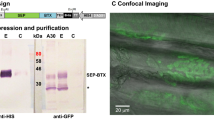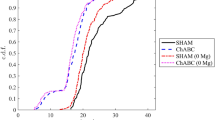Abstract
THE liberation of acetylcholine from the motor nerve endings in skeletal muscle is believed to take place in a quantal manner. The arrival of the action potential at the nerve terminals elicits the release of a number of packets of acetylcholine molecules of fairly uniform size, each of them producing a unit of depolarization in the post-synaptic membrane. This view is derived from the statistical analysis of the random step-wise fluctuations in the amplitude of successive end-plate potentials recorded from single neuromuscular junctions blocked by excess magnesium ions or lack of calcium ions1. The average magnitude of the steps was found to be identical with the mean size of the miniature end-plate potentials recorded from the same junction and due to the spontaneous extrusion of single acetylcholine quanta from the resting nerve endings.
This is a preview of subscription content, access via your institution
Access options
Subscribe to this journal
Receive 51 print issues and online access
$199.00 per year
only $3.90 per issue
Buy this article
- Purchase on Springer Link
- Instant access to full article PDF
Prices may be subject to local taxes which are calculated during checkout
Similar content being viewed by others
References
del Castillo, J., and Katz, B., J. Physiol., 124, 560 (1954).
Kuffler, S. W., J. Neurophysiol., 5, 309 (1942).
Author information
Authors and Affiliations
Rights and permissions
About this article
Cite this article
DEL CASTILLO, J. Quantal Nature of the End-plate Potential. Nature 176, 650–651 (1955). https://doi.org/10.1038/176650a0
Issue Date:
DOI: https://doi.org/10.1038/176650a0
This article is cited by
-
Calcium als intracellul�re �bertr�gersubstanz und die m�gliche Bedeutung dieses Mechanismus f�r pharmakologische Wirkungen
Klinische Wochenschrift (1964)
Comments
By submitting a comment you agree to abide by our Terms and Community Guidelines. If you find something abusive or that does not comply with our terms or guidelines please flag it as inappropriate.



